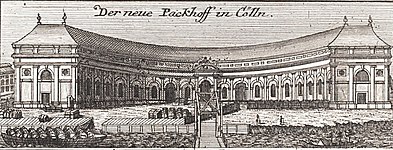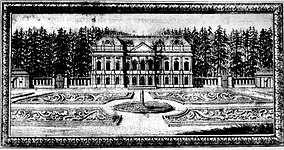Johann Arnold Nering
Johann Arnold Nering (also: Nehring ) (born January 13, 1659 in Wesel ; † October 21, 1695 in Berlin ) was a builder from the Elector of Brandenburg .
Life
His engineering training probably took place in Holland . Educational trips took him to Italy from 1677 to 1679 .
As early as 1682 Nering participated in the construction of the Köpenick hunting lodge , where the gate, the palace chapel and the gallery (?) Are attributed to him. In 1684, under the rule of the Great Elector Friedrich Wilhelm , he was appointed chief elector engineer. In the following year he was appointed engineer colonel in the general staff . Among other things, the elector drew him in in 1685 for the new building of the orangery house at the northwest end of the pleasure garden of the Berlin City Palace. In 1687 he designed Barby Castle for Duke Heinrich von Sachsen-Weißenfels .
For the young Elector Friedrich III. (from 1701 King Friedrich I) immediately after his accession to government in 1688, Nering joined the building commission for the construction of the new Friedrichstadt , where he was responsible for examining all the designs for the roughly three hundred two-story town houses. Nering's influence was also responsible for the construction of the Linden-Markt, a square that is now known as the Gendarmenmarkt and is the most beautiful square in Berlin. In 1690, Nehring designed a representative, free-standing entrance portal to the palace garden for Oranienburg Palace.
With his appointment as chief building director for the electoral Brandenburg on April 9, 1691, Nering determined the main buildings in pre-royal Berlin and Brandenburg; for example, reconstruction and expansion of Oranienburg Castle (1690–94), the construction of the Long Bridge (today's Rathausbrücke , 1692–95) and the Hetzgarten (1693).
As early as 1688 Nehring had been commissioned to plan the Berlin armory , but Elector Friedrich did not lay the foundation stone until 1695 shortly before Nering's early death due to lack of money. The construction of the armory was then continued by his successor as chief construction director, Martin Grünberg , subsequently Andreas Schlüter and finally by Jean de Bodt and was not completed until 1729.
Nehring also provided the construction plans for the Parochial Church in 1694; the foundation stone was laid on August 15, 1695, two months before Nehring's death. This building was also completed by Grünberg in a modified form.
Nering's work was characterized by Dutch and Italian influences, as can already be seen in the Köpenick Palace Chapel. His design for the Parochialkirche is considered to be one of the architect's most mature works, again he combined both styles; The main inspiration was evidently the Nieuwe Kerk in The Hague by Pieter Noorwits (1649/1656) and the church of Santa Maria della Consolazione in Todi (from 1508).
Nering also designed the summer residence of Electress Sophie Charlotte , which was later named after Charlottenburg Palace . In 1695 her husband gave her the village of Lietze / Lützow about seven kilometers from Berlin; In the same year, Sophie commissioned Charlotte Nering with the planning and construction of a small summer palace. However, Nering died a few months later, and Martin Grünberg took over the construction; The central part of the castle, which was extensively expanded from 1701 onwards, is still known as the Neringbau .
The Friedrichshof hunting lodge near Königsberg , later called Groß Holstein , was also based on a construction plan by Nering (based on the example of Schönhausen Palace near Berlin).
Johann Arnold Nering died in Berlin in 1695 at the age of only 36. He was buried in the vault of the Dorotheenstadt Church . When the church was rebuilt in 1861–1863, his remains were buried in the adjacent churchyard. The tomb was lost when the church and churchyard were leveled in 1965 at the latest.
In 1892, in honor of the master builder, Nehringstrasse near Charlottenburg Palace was named after him.
photos
Köpenick Castle , gate
Lustgarten and Orangery House (Berlin) (around 1695)
Lützenburg Palace (later Charlottenburg Palace ) around 1700
Charlottenburg Palace , the middle wing of which is the Nering building
Long Bridge by Nehring (1889)
Friedrichshof Hunting Lodge , East Prussia (around 1830)
Design for the Parochial Church
literature
- Lionel from Donop : Nering, Arnold . In: Allgemeine Deutsche Biographie (ADB). Volume 23, Duncker & Humblot, Leipzig 1886, pp. 431-435.
- Georg Fritsch : The castle church at Königsberg i. Pr. And their relations with Holland . Koenigsberg 1930.
- Georg Fritsch: Nering, Johann Arnold . In: Hans Vollmer (Hrsg.): General lexicon of fine artists from antiquity to the present . Founded by Ulrich Thieme and Felix Becker . tape 25 : Moehring – Olivié . EA Seemann, Leipzig 1931, p. 390-391 .
- Dorothee Nehring: Nering, Johann Arnold. In: New German Biography (NDB). Volume 19, Duncker & Humblot, Berlin 1999, ISBN 3-428-00200-8 , p. 64 f. ( Digitized version ).
- Gerda Nehring: Johann Arnold Nering. A Prussian builder . Essen 1985. 2nd edition Böblingen 2002, ISBN 3-00-009428-8 .
Web links
- Kathrin Chod, Herbert Schwenk, Hainer Weisspflug: Nehring, Johann Arnold . In: Hans-Jürgen Mende , Kurt Wernicke (ed.): Berliner Bezirkslexikon, Mitte . Luisenstadt educational association . Haude and Spener / Edition Luisenstadt, Berlin 2003, ISBN 3-89542-111-1 ( luise-berlin.de - as of October 7, 2009).
- Literature by and about Johann Arnold Nering in the catalog of the German National Library
Individual evidence
- ^ Hans-Jürgen Mende : Lexicon of Berlin burial places . Pharus-Plan, Berlin 2018, ISBN 978-3-86514-206-1 , pp. 40–41. Erika Schachinger: The Dorotheenstadt 1673–1708 . A Berlin suburb. Böhlau, Cologne a. a. 2001, ISBN 978-3-412-10601-0 , p. 62.
- ↑ Nehringstrasse. In: Street name lexicon of the Luisenstädtischer Bildungsverein (near Kaupert )
| personal data | |
|---|---|
| SURNAME | Nering, Johann Arnold |
| ALTERNATIVE NAMES | Nehring, Johann Arnold |
| BRIEF DESCRIPTION | builder from the Elector of Brandenburg |
| DATE OF BIRTH | January 13, 1659 |
| PLACE OF BIRTH | Wesel |
| DATE OF DEATH | October 21, 1695 |
| Place of death | Berlin |











